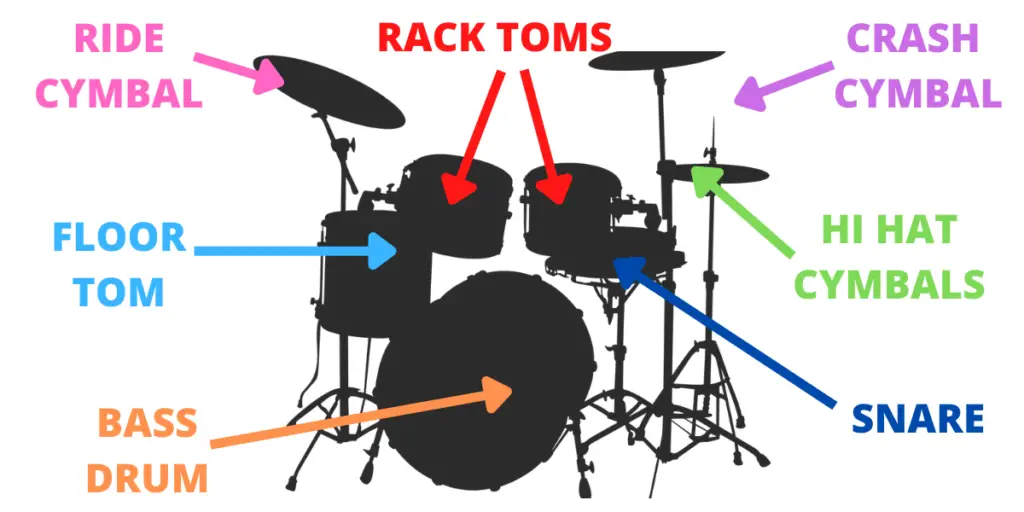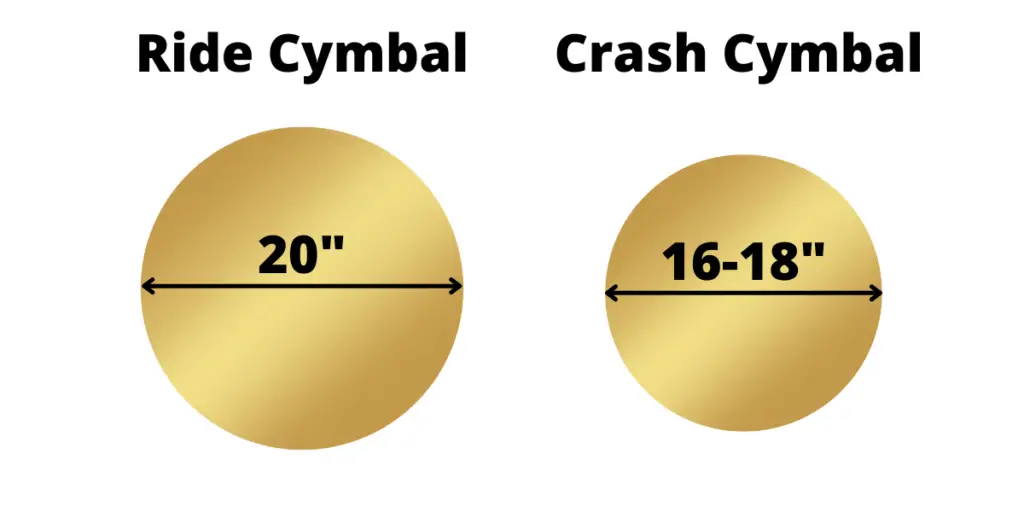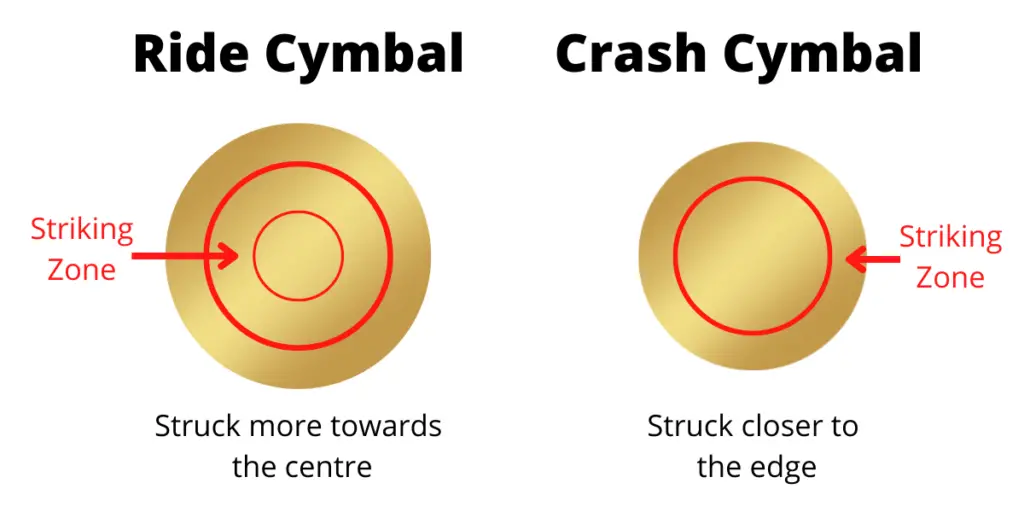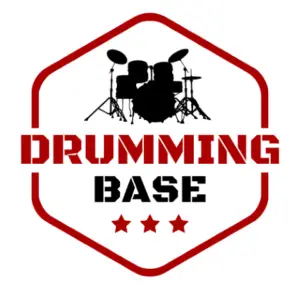Crash and ride cymbals are crucial components of a drum kit, but it be confusing figuring out which is which for new drummers. In this article I’ll explain the differences between crash and ride cymbals in terms of how they look, feel and sound and which to use when.
Crash vs Ride Cymbal 101
Ride cymbals are thicker and have a wider diameter compared to crash cymbals. Crash cymbals have more shimmer and sound brighter compared to ride cymbals. Ride cymbals are used more frequently as they function to help keep the beat, whereas crash cymbals are used sparingly to provide an accent.
| Ride Cymbal | Crash Cymbal |
| Typically have an 18-22” diameter | Typically have a 14-18” diameter |
| Thicker | Thinner |
| Struck closer to the center | Struck close to the edge |
| Sound short and sharp | Sound bright and shimmery |
| Used frequently to keep the beat | Used sparingly to provide an accent |
| Positioned on the right above the floor tom | Positioned on the left above the hi-hat |
| More expensive but less prone to cracking | Cheaper but more prone to cracking |
A crash cymbal produces a loud sound with a lot of shimmer. A drum kit will typically have two crash cymbals on either side, but smaller drum kits will just have a single crash cymbal. They are used for accents for example, when finishing a fill.
A ride cymbal is produces a short and sharp sound with very little shimmer. A drum kit will only have one ride cymbal which is used to keep the beat primarily in the chorus or higher energy sections of a song.

Physical Characteristics
Crash cymbals are thinner and have a smaller diameter compared to ride cymbals.
Crash cymbals vary in size and thickness but are typically 14-18″ (36 to 46 cm) in diameter. A thinner crash cymbal is used for classic rock and blues whereas a thicker crash cymbal is used for heavier styles of music such as metal.
Ride cymbals are typically 20″ (51 cm) in diameter but can range between 18-22″ (46 to 56 cm). Smaller and thinner ride cymbals sound darker and have more shimmer compared to larger and thicker ride cymbals which sound louder.
The easiest way to distinguish which is the crash cymbal and which is the ride cymbal when setting up a drum kit is to see which is the largest. The larger cymbal will be the ride cymbal.
Looking for more info on cymbal size and how it affects the sound? Check out my cymbal size guide to learn more.

Comparing the Sound
Crash cymbals also sound louder compared to ride cymbals, but this is due to their higher pitch as the human ear tends to perceive brighter sounds as louder.
Ride cymbals produce a short and sharp sound with less shimmer compared to crash cymbals. Crash cymbals are characterised by their bright and shimmery tone that has longer sustain. Crash cymbals sound brighter and harsher compared to ride cymbals because they are thinner.
Check out this YouTube video to hear the sound difference.
When to Use Which Cymbal
The ride cymbal is used more frequently than the crash cymbal.
The ride cymbal is typically are used to maintain the beat during higher energy parts of a song. For example, it is common to use a ride cymbal during the chorus as it produces a louder sound compared to the hi-hat cymbals which are used during the verse.
The crash cymbal is used sparingly since it produces a loud and shimmery tone which is overpowering when used throughout the whole sound. Instead, the crash cymbal is used to accent. For example, a crash cymbal may be used when transitioning from a verse to a chorus or when starting or finishing a fill.
The crash cymbal is used more frequently in heavier genres such as rock and metal and can be used to keep the beat in some cases. However, overuse should be avoided as it can sound messy particularly if the other instruments in the band are not as aggressive.
Wondering if you can actually crash a ride cymbal? Check out this article to learn more.
Cymbal Positioning
The ride cymbal is usually placed on the right hand side of the drum kit (near the floor tom) , and is positioned slightly lower compared to the crash cymbal which is located just above the hi-hat.
If there is only one crash cymbal, it is usually placed on the left, but if there are two crash cymbals then they can be placed on either side above the ride cymbal.
The ride cymbal is placed lower than the crash cymbal because you hit it more often and it feels more natural when used to keep the beat. Since the crash cymbal is used sparingly it is placed higher up so it is out of the way of the other drums.

Where Should You Strike the Cymbal?
A ride cymbal is typically struck on the body, closer to the bell (centre) rather than towards the edge using the tip of the drumstick. This helps it sound clear and articulate and prevents it from sounding too dark.
A crash cymbal is usually hit on the edge using the shoulder of the drumstick with a glancing motion. This helps to produce that shimmery tone.

Durability and Price
Crash cymbals range from $50-$500, however on average a good quality crash cymbal will cost at least $200 on average. Ride cymbals can cost between $70 and $700 but most good quality ride cymbals will start at around $300.
Crash cymbals break more easily because they are thinner and they are hit at the edges. This means they are more likely to crack compared to ride cymbals which are thicker and less prone to damage because they are struck more centrally where the metal is thicker.
The thicker the cymbal is, the less likely it is to crack.
What is a Crash/ Ride Cymbal?
Crash/ ride cymbals usually have a diameter between 16-20″ (41-51 cm) and function as both a crash and ride cymbal so they can be used to keep the beat when struck towards the centre, or to produce a crashing sound for accents when hit towards the edge.
You can also get ride/ crash cymbals which again have that dual function but are usually thicker and heavier so favour the ride function.
There are several reasons why you may want to use a crash/ ride cymbal:
- In a small, entry-level drumkit sometimes a crash/ride cymbal is supplied instead of separate crash and ride cymbals. This helps to save space and keep the cost of the kit lower.
- At lower volumes the “ride” function will be quieter. A popular use of this is in jazz music.
- At higher volumes the “crash” function will be louder fuller which is useful for more aggressive styles of music.
Check out this in-depth comparison between ride and hi-hat cymbals.
Here are some more articles you might find useful:

